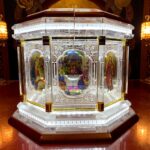The Coptic Orthodox Church carries many symbols in its prayers and rituals. Each instrument used in the church has a meaning and is intended to help us to come closer to God during our prayers. The church attempts to make prayer and worship a meaningful reminder of things that happened in the Bible and an atmosphere mimicking the worship in heaven in front of the throne of God.
The Throne (Ark)
In the middle of the Altar, there is a box, called in Coptic ‘pi totc’ which means ‘a seat’ or ‘a throne’, and is used as a Chalice-Stand. Usually it is cubicle in shape, and the top is closed with high flaps. It is called the Ark because the Blood with gives life to who ever drinks from it is represented by the pot of Manna which was in the Ark of covenant and was a symbol of the true Body of Christ.
The Chalice
The Communion Cup, into which wine mixed with water is poured and is converted into the Blood of the Lord Jesus Christ through the Divine Liturgy. The Lord Himself used the chalice (Matthew 26:26-27) and the Apostles imitated Him. St. Paul the Apostle calls it “the Cup of Blessing” and “the Cup of the Lord”. (1 Corinthians 10:16, 21). Tertullian refers to it as having the shape of lamb engraved outside it, to remind us of the Lamb of God Who purchased His Church and adorned her entirely with His Holy Blood.
The Paten
A small round tray, without a stand and having no engraving. It is usually made of silver or gold. This paten has a symbolic meaning, as it represents the Lord’s manger and tomb. The Lord Jesus Christ in the Last Supper used a paten and chalice (Matthew 26:26-27) and following Him the Apostles did the same (1 Corinthians 10:16)
The Dome (Star)
Made of two arches that cross together and form the shape of a cross This dome is put on the paten representing the Lord’s grave or manger. On top of it is a cross referring to the sheltering cherubim, or the star on top of Jesus’s manger. Represents the star that appeared to the wise men and stopped above the house where the Child Jesus lay.
The Censer
One of the first gifts offered to Christ while He was yet an infant was the frankincense, a costly gift of love which should be offered to Him by His people today. “For from the rising of the sun even unto the going down of the same, My Name shall be great among the Gentiles, and in every place incense shall be offered unto My Name, and a pure offering” (Malachi 1:10, 11).
For from the rising of the sun even unto the going down of the same, My Name shall be great among the Gentiles, and in every place incense shall be offered unto My Name, and a pure offering.
Malachi 1:10-11
In the Book of Revelation, St. John the Beloved saw incense being burned by an angel in a golden censer to “offer it with the prayers of all the saints” (Revelation 8:3-4). Each component of the censor is symbolic of a belief of the Church:
- The upper dome represents heaven
- The lower dome represents the womb of St. Mary
- The coal represents Christ’s Humanity
- The fire represents Christ’s Divinity
- The incense on top of the coal is the aroma that we received when he represented Himself as a true Sacrifice, and we smelled him, as did His Good Father
- The three chains represent the Trinity, and are united by one chain in the Middle (the unity of the Trinity).

